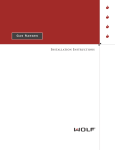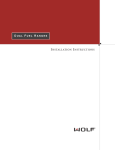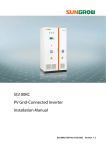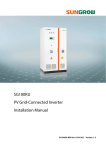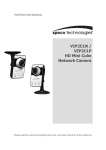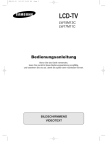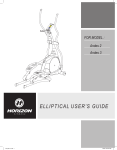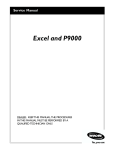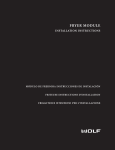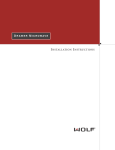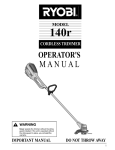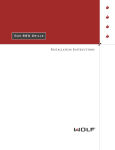Download Wolf DUAL FUEL RANGES User's Manual
Transcript
D U A L F U E L R A N G E S I N S T A L L A T I O N I N S T R U C T I O N S I M P O R T A N T I N F O R M A T I O N IMPORTANT NOTE: This installation must be completed by a qualified installer, service agency or gas supplier. • INSTALLER: please retain these instructions for local inspector’s reference, then leave them with the homeowner. • Please read the entire installation instructions prior to installation. • HOMEOWNER: please read and keep these instructions for future reference. • Please read the entire Wolf Dual Fuel Ranges Use & Care Information book prior to use. As you follow these installation instructions, take particular note of the CAUTION and WARNING symbols when they appear. This information is important for the safe and efficient installation of Wolf Dual Fuel Ranges. CAUTION signals a situation where minor injury or product damage may occur if you do not follow instructions. WARNING states a hazard that may cause serious injury or death if precautions are not followed. This appliance must be installed in accordance with all National Electrical Codes, as well as all state, municipal and local codes. The correct voltage, frequency and amperage must be supplied to the appliance from a dedicated, grounded circuit that is protected by a properly sized circuit breaker or time delay fuse. The proper voltage, frequency, and amperage ratings are listed on the product rating plate. Record the model and serial numbers before installing the range. Both numbers are on the rating plate, located on the bottom of the control panel assembly just above the oven door on the far right. Model # In addition, the printed instructions may signal an IMPORTANT NOTE, which highlights information that is especially important for a problemfree installation. 2 Serial # P R E -I N S T A L L A T I O N WARNING If the information in this manual is not followed exactly, a fire or explosion may result causing property damage, personal injury or death. Do not store or use gasoline or other flammable vapors and liquids in the vicinity of this or any other appliance. WHAT TO DO IF YOU SMELL GAS: • Do not try to light any appliance. • Do not touch any electrical switch. • Do not use any phone in your building. • Immediately call your gas supplier from a neighboring phone. Follow the gas supplier’s instructions. • If you cannot reach your gas supplier, call the fire department. BEFORE YOU START SITE PREPARATION • This range is manufactured for use with natural gas or LP. Please check range rating plate for type of gas needed. IMPORTANT NOTE: Make sure that protective material is used on the floor prior to positioning the range. Failure to do so may result in damage to the floor covering. • Proper installation is your responsibility. Have a qualified technician install this range. Installations must be performed by a qualified or licensed contractor, plumber or gas fitter, qualified or licensed by the state, province or region where this appliance is being installed. You must also assure that electrical installation is adequate and in conformance with all local codes and ordinances. • Make sure you have everything necessary for correct installation. It is the responsibility of the installer to comply with the installation clearances specified on the model / serial rating plate, located on the bottom of the control panel assembly just above the oven door on the far right. • Check the location where the range will be installed. The location should be away from strong draft areas, such as windows, doors and strong heating vents or fans. Do not obstruct flow of combustion and ventilation air. • All openings in the wall or floor where the range is to be installed must be sealed. • When installing the range under existing cabinets and the installation does not meet the minimum cabinet clearances, install a range hood or other non-combustible surface above the range to avoid burn hazards. • Proper gas supply connection must be available, refer to Gas Supply Requirements on page 8. Electrical ground is required, see Electrical Requirements on page 9. IMPORTANT NOTE: Please remove the oven door(s) prior to lifting on the front of the unit, see pages 4-5. This can lower the overall weight of the unit by 50-100 lbs., depending on the size of the unit. 3 P R E -I N S T A L L A T I O N UNPACK THE RANGE • Remove all packing materials, including cardboard and tape, located outside and within the oven cavity. • Remove the oven racks and broiler pan from within the oven cavity. Do this for both oven cavities on the 48inch and 60-inch ranges. • Remove the grates and styrofoam off the top cooking surface. Be sure to remove the burner caps packaged in styrofoam below the grates. • Lift the unit off the pallet. Remember, range is heavy. Remove the styrofoam from the bottom of the unit. • Be sure not to discard the angle iron supplied with the range as this is the anti-tip bracket and must be installed on the unit. Refer to Anti-Tip Bracket Installation on page 11. REMOVE THE OVEN DOOR(S) • The rear of the range has rolling casters which allows for easy movement of the range by picking up on the front of the unit. Do not lift by oven door handle(s). See illustration below. NOTE: The range comes from the factory at an overall height of 35-7/8" (from floor to the top of the bullnose) before any height adjustment. The legs and casters allow for 2-1/8" height adjustment. Refer to the chart and the Installation Dimensions illustrations on pages 6-7 for additional dimensions. WARNING The rear of the range has rolling casters which allows easy movement of the range by picking up on the front of the unit. CASTERS ALLOW 2 1/8" HEIGHT ADJUSTMENT Rolling Casters 4 WARNING Do not lift or carry the oven door by the door handles. Failure to insert supplied pin in appropriate hinge arm will cause damage to unit, and possible minor injuries may occur. Due to the weight of this appliance removing the oven door(s) will significantly reduce the lifting load, while also providing the installer with a place to grip the range when pushing it into place. VENTILATION CONSIDERATIONS NOTE: Only one of the hinge arms is spring loaded, which requires use of the hinge pin for removal. Refer to the following illustrations for the location of the hinge pin on various models. For 30-inch and 36-inch units, the hinge pin will be inserted through the hole in the right hinge arm (looking at the front of the unit), see figure 1. On 48-inch and 60-inch units, the spring hinges are located on the outside edges of the unit. On these units, the left oven door will have the spring hinge on the left side. The right oven door will have the spring hinge on the right side. Refer to figure 2 below. Oven Door Removal: • Open the oven door to its fully opened position. • Remove the screw and plate. • Insert the supplied pin (found taped to inside of oven door) through hole in the appropriate hinge arm. See illustration below. • Lift the oven door to about a 60degree angle from the horizontal. Pull the door away from the oven while continuing to lift. • For 48-inch and 60-inch units, complete this procedure for both the left and right oven doors. PLATE IMPORTANT NOTE: Do not install or operate your Wolf Dual Fuel Range without a ventilation hood. • Start the ventilation hood approximately five minutes before cooking; this establishes an air curtain, and improves the capture of vapor and moisture. • Blower requirements may vary due to length of duct work and number of angles. The basic recommendation is 100-150 net CFM per square foot of cooking area. Consult with your HVAC representative for more concise blower requirements. SCREW HINGE PIN PLACE PIN ON SPRING HINGE SIDE OF UNIT Figure 1 – Spring Hinge Location 30-inch and 36-inch units Oven Door Removal PLACE PINS ON SPRING HINGE SIDE OF UNIT Figure 2 – Spring Hinge Location 48-inch and 60-inch units 5 P R E -I N S T A L L A T I O N INSTALLATION CONSIDERATIONS • Each unit is designed to fit between cabinets set at the distance specified by the unit (i.e. a 36-inch unit will fit a 36" opening). The exception is the 60-inch unit which will require a 601/4" opening. • Unit is designed with a terminal block on the rear of the range. The terminal block will also accept an appliance power cord. Have a certified electrical contractor wire your unit from the junction block to the terminal block on the range. NOTE: Refer to the chart below and the Installation Dimensions illustrations on the following page for exact rough opening dimensions. IMPORTANT NOTE: Cabinet opening dimensions that are shown must be used. Given dimensions provide for required clearances. NOTE: Maintain an 18" (45.7 cm) minimum clearance from upper cabinet to countertop, within 6" (15.2 cm) minimum side clearance to combustible surface above countertop. ISLAND OR PENINSULA INSTALLATIONS NOTE: Maintain a 30" (76.2 cm) minimum clearance between top of cooking surface and bottom of wood or metal cabinet, which is protected by not less than 1/4" (.6 cm) flame retardant millboard covered with not less than No. 28 MSG sheet steel, .015" (.04 cm) stainless steel, or .024" (.06 cm) aluminum or .02" (.05 cm) copper. Maintain a 36" (91.4 cm) minimum clearance between top of cooking surface and bottom of an unprotected wood or metal cabinet. IMPORTANT NOTE: Locate the junction box within dimensions shown, flush with back wall. Island Installation: Unit should not be installed within an enclosure having an adjacent rear wall that rises above the cooking surface. Refer to the chart below and the Installation Dimensions illustrations on the following page. Peninsula Installation: Unit has a 6-inch minimum clearance to the side wall, left or right side, and 12-inch minimum clearance to the rear wall. NOTE: Refer to the chart below and the Installation Dimensions illustrations on the following page for exact rough opening dimensions. • Total rating: 5.2 kW (240V) for 30-inch and 36-inch units, 10.2 kW (240V) for 48-inch and 60-inch units. • Total Amps: 22 amps for 30-inch and 36-inch units, 43 amps for 48-inch and 60-inch units. Installation Dimensions 30" Range 36" Range 48" Range 60" Range 29 7/8" 35 7/8" 47 7/8" 60 1/8" 30 " 36 " 48 " 60 1/4" 8 1/ 2" 8 1/ 2" 24" 31" D Location of gas supply 10" 15" 10" 10" E 13" 19" 13" 13" A Overall width of range (width may vary to B Finished rough opening width C Dimension from edge of rough opening +1/8") Location of electrical Note: Dimensions correspond to the illustrations on the following page. 6 INSTALLATION DIMENSIONS 29 1/2" (74.9) OVERALL DEPTH 27 1/2" (69.9) 24 1/4" (61.6) 35 7/8" 36 7/8" (91.1) (93.7) OVERALL HEIGHT 36 7/8" (93.7) TO COOKING SURFACE 25" (63.5) A LEGS AND CASTERS ALLOW 2 1/8" HEIGHT ADJUSTMENT OVERALL WIDTH COMBUSTIBLE CONSTRUCTION VENTILATION HOOD 13" max (33.0) 30" min (76.2) COOKING SURFACE TO COMBUSTIBLE CONSTRUCTION 30" min (76.2) TO BOTTOM OF VENTILATION HOOD 44" min (91.4) TO CHARBROILER 18" min (45.7) TO COOKING SURFACE 6" min (15.2) TO WALL COOKING SURFACE B FINISHED ROUGH OPENING WIDTH 36" (91.4) D C LOCATION OF GAS SUPPLY 3 1 /4 " 36 7/8" (93.7) TO COOKING SURFACE (8.3) E LOCATION OF GAS AND LOCATION OF ELECTRICAL EXTENDS 3" ELECTRICAL ON FLOOR FROM BACK WALL ISLAND INSTALLATIONS: 12" MINIMUM CLEARANCE FROM BACK OF RANGE TO COMBUSTIBLE CONSTRUCTION 7 I N S T A L L A T I O N GAS SUPPLY REQUIREMENTS WARNING EXPLOSION HAZARD – • Use a new CSA approved gas supply line and install a gas shut-off valve. • Securely tighten all gas connections. • If connected to LP, have a qualified person make sure gas pressure does not exceed 14 inches water column. • Failure to do so can result in explosion, fire or death. IMPORTANT NOTE: Observe all governing codes and ordinances. IMPORTANT NOTE: Range must be connected to a regulated gas supply. • This installation must conform with local codes and ordinances. In the absence of local codes, installations must conform with American National Standard, National Fuel Gas Code ANSI Z223.1 – latest edition or CANI – B149.1 or 2. • The range is equipped for use with natural gas or LP. It is design certified by the Canadian Standards Association (CSA) for natural or LP gases. The model / serial rating plate, located on the bottom of the control panel assembly just above the oven door on the far right, has information on the type of gas that should be used. If this information does not agree with the type of gas available, check with the local gas supplier. 8 • Provide a gas supply line of 3/4" rigid pipe to the range location. A smaller size pipe on long runs may result in insufficient gas supply. Pipe joint compounds, suitable for use with LP gas should be used. For LP gas, piping or tubing size can be 1/2" minimum. LP gas suppliers usually determine the size and materials used on the system. • If local codes permit, a new CSA design-certified, 3-foot long, 1/2" or 3/4" ID, flexible metal appliance connector is recommended for connecting this range to the gas supply line. Do not kink or damage the flexible connector when moving the range. The pipe coming out the bottom of the unit has 1/2" male threads. You will need to determine the fittings required, depending on the size of your gas supply line, flexible metal connector and shut-off valve. • The supply line must be equipped with an approved shut-off valve. This valve should be located in the same room as the range and should be in a location that allows ease of opening and closing. Do not block access to the shut-off valve. The valve is for turning on or shutting off gas to the appliance. See illustration. • If rigid pipe is used as a gas supply line, a combination of pipe fittings must be used to obtain an in-line connection to the range. All strains must be removed from the supply and fuel lines so range will be level and in line. • The regulator must be checked at a minimum 1-inch (2.5 cm) water column above the set pressure. The inlet pressure to the regulator should be as follows for operation and checking the regulator setting. Natural Gas: • Set pressure 5 inches (11.4 cm) • Supply pressure 7-14 inches (17.8 cm - 35.5 cm) max. LP Gas: • Set pressure 10 inches (25.4 cm) • Supply pressure 14 inches (35.5 cm) SHUT-OFF VALVE (open position) GAS SUPPLY LINE TO APPLIANCE Shut-off Valve LINE PRESSURE TESTING Testing above 1/2 psi (3.5 kPa) 14" (35.6 cm) WC (gauge) The range and its individual shutoff valve must be disconnected from the gas supply piping system during any pressure testing of that system at test pressures greater than 1/2 psig (3.5 kPa). ELECTRICAL REQUIREMENTS WARNING Verify that power is disconnected from junction box before proceeding. • Maximum connected load: 5,200 W (30-inch and 36-inch units), Testing below 1/2 psi (3.5 kPa) 14" (35.6 cm) WC (gauge) or lower The range must be isolated from the gas supply piping system by closing its individual manual shut-off valve during any pressure testing of the gas supply piping system at test pressures equal to or less than 1/2 psig (3.5 kPa). 10,000 W (48-inch units), 10,200 W (60-inch units). • Required power supply: 240V / 30A / 60Hz (30-inch and 36-inch units), 240V / 50A / 60Hz (48-inch and 60inch units). • Minimum supply wire size (30-inch and 36-inch units): L1 and L2 12 AWG, neutral - 16 AWG, ground 12 AWG. • Minimum supply wire size (48-inch and 60-inch units): L1 and L2 8 AWG, neutral - 12 AWG, ground 10 AWG. The terminal block on the rear of the range allows for 3-wire or 4-wire installations. For a 4-wire installation, the ground strap from the unit to the terminal block must be cut. Two concentric knockouts are provided to allow for permanent or cordset wiring of the unit. Please refer to state, municipal and local codes for the best means to connect the appliance to the electrical power supply. For UL installations: Attach the conductors to the residence wiring in accordance with National Electrical Codes and all state, municipal and local codes. For CSA installations: Attach the conductors to the fuse box provided. Then connect the residence wiring to the fuse box in accordance with all national, provincial, and local codes. Then, depending upon local codes, utilize one of the following techniques to connect the appliance to the electrical power supply. Connecting to a Four-Wire Electrical System • Cut and / or remove the ground strap on the terminal block. • Connect the white appliance wire to the neutral (white) supply wire on the terminal block. • Connect the black appliance wire to the black (L1) power supply wire on the terminal block. • Connect the red appliance wire to the red (L2) power supply wire on the terminal block. • Connect the ground appliance wire to the green /ground house grounding wire on the terminal block. 9 I N S T A L L A T I O N GAS SUPPLY LINE CONNECTION Connecting the Ground Appliance Wire to the Neutral (white) Supply Wire (three-wire system) Where Local Codes Permit – • Connect the ground and white appliance wires to the neutral (white) supply wire on the terminal block. • Connect the black appliance wire to the black (L1) power supply wire on the terminal block. • Connect the red appliance wire to the red (L2) power supply wire on the terminal block. IMPORTANT NOTE: All connections must be wrench-tightened. Do not make connections to the gas piping too tight. Making the connection too tight may crack the regulator and cause a gas leak. Do not allow the pipes to turn when tightening fittings as the tubing in the burner box may also bend and begin to leak. • Use a pipe-joint compound made for use with natural and LP gas. If a flexible metal connector is used, be certain the tubing is not kinked. • Open the shut-off valve in the gas supply line. Wait a few minutes for the gas to move through the line. Refer to the illustration on page 8. • Assemble the flexible metal connector from the gas supply pipe to the pressure regulator. You will need to determine the fittings required, depending on the size of your gas supply line, flexible metal connector and shut-off valve. See illustration below. PRESSURE REGULATOR SHUT-OFF VALVE ADAPTER NIPPLE (use pipe-joint compound on ends) FLEXIBLE METAL CONNECTOR Gas Supply Line Connection 10 ADAPTER ELBOW (use pipe-joint compound on ends) ANTI-TIP BRACKET INSTALLATION Leak testing of the appliance shall be conducted according to the following instructions: Use a brush and liquid detergent to test all gas connections for leaks. Bubbles around connections will indicate a leak. If a leak appears, shut off gas valve controls and adjust connections. Then check connections again. Clean all the detergent solution from the range. WARNING Never test for a gas leak with a match or other flame. • Put the burner heads on each burner base. Place the burner grates over the burner bases and heads. WARNING This range can tip. Injury to persons could result. Install the anti-tip device packed with this range. Follow these installation instructions. WALL SIDE PANEL ANTI-TIP BRACKET BASE FLANGE • Raise the unit to its desired height using the rear leveling casters and adjusting the front adjustable legs. Try fitting the unit in place to verify the correct height. • Measure from the floor to the top of the range base flange on the back of the unit. 5 3/4" min TO FLOOR FLOOR Anti-tip Bracket Installation • Add 1/8" to this dimension, and mark this height on the wall behind the unit. This will be the location of the bottom edge of the anti-tip bracket. Try to center the mark between the cabinets. For 48-inch and 60-inch ranges, care must be taken to verify that the anti-tip bracket does not interfere with the inner cavity supports. • Locate a stud or other solid mounting source, and install the anti-tip bracket at the same level as this line. • Push the unit back, and ensure the rear base flange fits under the anti-tip bracket. 11 I N S T A L L A T I O N ELECTRONIC IGNITION INITIAL LIGHTING REINSTALL OVEN DOOR(S) Range burners use electronic igniters in place of standing pilots. When the range control knob is pushed in and turned to the "HIGH" position, the system creates a spark to light the burner. This sparking continues until the electronic ignition senses a flame. Ovens door(s) have been removed according to the procedure described on pages 4-5. Follow these instructions to reinstall. • Check operation of the range burners. Push in and turn each control knob to "HIGH" position. The flame should light within four seconds. • If burners do not light properly, turn control knob to the "OFF" position. Check that burner head is in the proper position. Check that the unit is properly wired to house supply and that the circuit breaker or house fuse has not blown. Check that the shutoff valve is in the "ON" position. Check operation again. If a burner does not light at this point, contact your dealer for assistance. Oven Door Reinstallation: • Grasp the oven door on opposite sides and lift it until the door hinges are aligned with the openings in the oven frame. • Holding the door at about a 30degree angle from the vertical, slide the hinges into the openings until the bottom hinge arms drop fully into the hinge receptacles. IMPORTANT NOTE: Fully extend the hinge claw, which is opposite the hinge pin location, and insert into hinge pocket prior to inserting opposite side. This will ease installation of door. • Lower the door to the fully opened position. Remove pin from the appropriate hinge arm. • Reinstall the plate and screw over the hinge claw. Refer to the following illustration. • Open and close the door completely to ensure that it is properly installed. • For 48-inch and 60-inch units, complete this procedure for both the left and right oven doors. 12 PLATE HINGE PIN Reinstall Oven Door SCREW WIRING DIAGRAM VERIFY RANGE OPERATION The wiring diagram covering the control circuit is located behind the skirt / lower panel, below the oven door panels. IMPORTANT NOTE: Prior to operating the range, please read the accompanying Wolf Dual Fuel Ranges Use & Care Information carefully. Important safety, service and warranty information is contained within this book. • Slide the oven racks (3 per oven, 2 in 18-inch oven) onto the support racks within the oven. Place the broiler pan and grid on a rack within the oven, if desired. The control panel should be closed (no visible control pads). Turn on the power supply to the range. Touch and slightly depress the dimple area to pivot the control panel open. • Select any of the eight cooking modes by using the oven control knob bezel and turning to the desired mode. Once the mode has been selected, the temperature can be adjusted by turning the temperature readout knob clockwise to increase the temperature or counterclockwise to decrease the temperature. Verify that the oven is coming up to temperature as described in the Wolf Dual Fuel Ranges Use & Care Information. • If checking the operation of a 48-inch or 60-inch range, repeat this procedure for the opposite oven. • Set the time of day by pressing the CLOCK touch pad, scroll to the desired time by using the up / down arrows, then touch ENTER. After setting the time, this control panel can be shut. The panel does not have to be open to operate the oven. 13 I M P O R T A N T I N F O R M A T I O N SERVICE INFORMATION CLEANING AND MAINTENANCE IMPORTANT NOTE: If the Dual Fuel Range does not operate properly, follow these troubleshooting steps: If removing the range is necessary for cleaning or maintenance, shut off gas supply. Disconnect the gas and electric supply. After disconnecting the gas and electric supply, finish removing the unit for cleaning and servicing. Reinstall in reverse order and check gas connection for leaks. • Verify that power is being supplied to the unit. • Check the electrical connections to ensure that the installation has been completed correctly. • Check that the gas shut-off valve is turned to the "ON" position. • Follow troubleshooting procedures as described in the Wolf Dual Fuel Ranges Use & Care Information. • If the appliance still does not work, contact a Wolf Factory Authorized Service Center. Do not attempt to repair the appliance yourself. Wolf is not responsible for service required to correct a faulty installation. To obtain the name and number of a Wolf Factory Authorized Service Center, call Wolf Customer Service at (800) 332-9513 or check our website; www.wolfappliance.com, or e-mail; [email protected]. When calling for service, you will need the range model and serial numbers. Both numbers are on the rating plate, located on the bottom of the control panel assembly just above the oven door on the far right. 14 WARNING Be sure to disconnect the gas and electric supply before cleaning or servicing. The information and images are the copyright property of Wolf Appliance Company, LLC, an affiliate of Sub-Zero Freezer Company, Inc. Neither this book nor any information or images contained herein may be copied or used in whole or in part without the express written permission of Wolf Appliance Company, LLC, an affiliate of Sub-Zero Freezer Company, Inc. © Wolf Appliance Company, LLC all rights reserved. W OLF A PPLIANCE C OMPANY, LLC P. O. Box 44848 • Madison, WI 53744 • 800-332-9513 www.wolfappliance.com 804199A 12/02
















